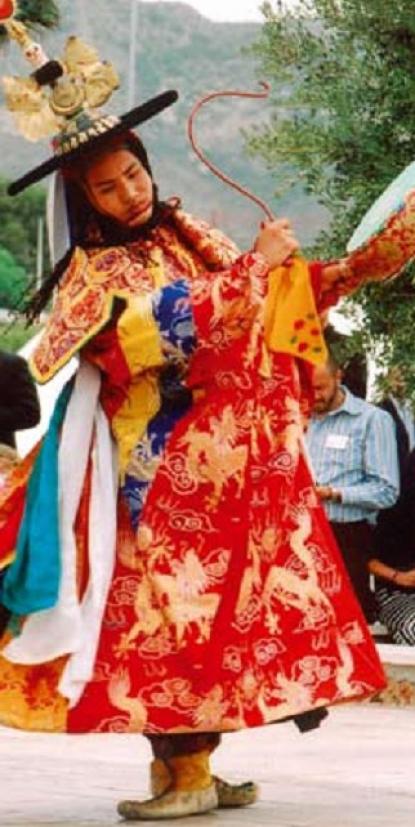2025. March 14. Friday
Ottó Herman Museum Exhibition Building - Miskolc
|
|
Address: 3530, Miskolc Papszer utca 1.
Phone number: (46) 346-875
E-mail: latogato@hermuz.hu
Opening hours: Temporarily closed.
|
The exhibition has closed for visitors.
2010.09.28. - 2010.10.10.
Museum tickets, service costs:
|
Group ticket
(up to 20 people)
|
3000 HUF
|
|
|
Group ticket
(21-35 people)
|
4500 HUF
|
|
|
Ticket for adults
|
600 HUF
|
|
|
Ticket for students
|
300 HUF
|
|
|
Ticket for pensioners
|
300 HUF
|
In Tibetan art statues and pictorial representations have symbolic interpretations, in addition to purely aesthetic considerations. The statues and pictorial representations are to help the practitioner to perceive the nature of consciousness. Forms of Buddha express various qualities of consciousness. In pictures they are usually in mandalas, the maps of enlightened energy field of surrounding them. These painted shapes (sometimes made of sand) look like the ground-plan for a palace or an air-photo of it.

Dorje, the most important symbol of Tibetan art, is held in the hand of many forms of Buddha. The dorje is the symbol for the indestructible power of consciousness and useful methods motivated by compassion. The other object often to be discovered in Tibetan art is the bell. While the dorje represent male quality, the bell expresses female quality, intuitive wisdom and space. The sound of bell symbolises the sound of teachings, its fainting sound symbolises the ephemeral nature of life.
Another important symbol is the mala, a symbol similar to western rosary. Malas are used to count mantras. It is made up of 108 beads and a central, so-called Eye of Buddha. The mala symbolises escape from Samsara. Various tools to cut, swords and daggers mostly symbolise negative emotions and rigid imagination.
Stupas are the oldest forms of architecture in Tibet, symbols of the perfection of consciousness, peace and happiness, they say in Tibet, they are embodiments of countless best wishes. In the heart of the building, relics of great teachers and realisers, copies of teachings of Buddha, mantra rolls and other interesting objects are placed. There are eight shapes of stupas, all of them reflect on an important stage in Buddha's life.
Treasures from Tibet
The culture of Tibet is one of the most special pieces of the spiritual heritage of humanity. The treasures, most of it from the old flourishing civilisation of India, were kept and enriched for over one millennia in the Himalayans.
But Tibet is unique for something else, too. While the west aimed at learning about the material world, the east turned inward. Their intention was to learn about how human consciousness worked. They did not term it as 'self' or 'soul' but as infinite flow of physically and mental impressions that, in terms of supreme nature, is inseparable from space. For this it experiences itself as indestructible and shining consciousness. Recognising its real nature, we will have no fear, experience joy born of its own and are able to express active compassion.
The statues and thangas witnesses of our inner world. Their various forms are all symbols of the perfect characteristics of consciousness. The works of art, also means used in meditation, artistic expression is undividable from inspiration to inner development.
Works of art on display are not only the last memories of a vanishing world but also mediators of values that are their in every single person and forever.

Dorje, the most important symbol of Tibetan art, is held in the hand of many forms of Buddha. The dorje is the symbol for the indestructible power of consciousness and useful methods motivated by compassion. The other object often to be discovered in Tibetan art is the bell. While the dorje represent male quality, the bell expresses female quality, intuitive wisdom and space. The sound of bell symbolises the sound of teachings, its fainting sound symbolises the ephemeral nature of life.
Another important symbol is the mala, a symbol similar to western rosary. Malas are used to count mantras. It is made up of 108 beads and a central, so-called Eye of Buddha. The mala symbolises escape from Samsara. Various tools to cut, swords and daggers mostly symbolise negative emotions and rigid imagination.
Stupas are the oldest forms of architecture in Tibet, symbols of the perfection of consciousness, peace and happiness, they say in Tibet, they are embodiments of countless best wishes. In the heart of the building, relics of great teachers and realisers, copies of teachings of Buddha, mantra rolls and other interesting objects are placed. There are eight shapes of stupas, all of them reflect on an important stage in Buddha's life.
Treasures from Tibet
The culture of Tibet is one of the most special pieces of the spiritual heritage of humanity. The treasures, most of it from the old flourishing civilisation of India, were kept and enriched for over one millennia in the Himalayans.
But Tibet is unique for something else, too. While the west aimed at learning about the material world, the east turned inward. Their intention was to learn about how human consciousness worked. They did not term it as 'self' or 'soul' but as infinite flow of physically and mental impressions that, in terms of supreme nature, is inseparable from space. For this it experiences itself as indestructible and shining consciousness. Recognising its real nature, we will have no fear, experience joy born of its own and are able to express active compassion.
The statues and thangas witnesses of our inner world. Their various forms are all symbols of the perfect characteristics of consciousness. The works of art, also means used in meditation, artistic expression is undividable from inspiration to inner development.
Works of art on display are not only the last memories of a vanishing world but also mediators of values that are their in every single person and forever.
